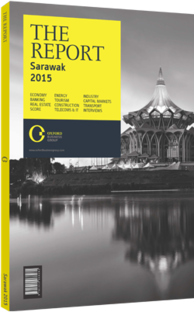OBG talks to Mior Ahmad Baiti, CEO, Bintulu Port Holdings

Interview: Mior Ahmad Baiti
What factors have accounted for the recent increase in vessel calls to Bintulu Port, and from which industries are the highest rates of activity coming?
MIOR AHMAD BAITI: If you consider the increase in vessel calls to Bintulu Port by category, the most substantial increase has been in offshore supply vessels from oil and gas platforms. That being said, increases have been experienced all across the board and in all types of cargo. Bintulu Port has experienced a significant spike in cargo activity as a result of an overall increase in offshore activity over the past one or two years.
In terms of other traditional industries, the resources industry in Sarawak is no longer a source of growth, with the economy shifting away from primary resources and refocusing around heavy industry and oil and gas. While palm oil is still steadily increasing in volume, this increase is not substantial. Timber is experiencing a decrease of almost 30% in the amount of timber product being handled yearly. However, new industries – such as those at the Samalaju Industrial Park near to Bintulu – are offsetting this decline in primary resources and driving new growth. As we see more of the current investors at Samalaju begin production, these numbers should increase further.
To what extent has the port reduced its reliance on liquefied natural gas (LNG), and what strategies are set to diversify the cargo handled at the port?
MIOR: It is certainly high time to go into other cargo sectors, whether that be dry bulk or liquid bulk containers. While there is growth in these cargo segments, it is not enough to truly diversify away from LNG. As much as diversification is desirable, LNG remains the major cargo handled at the port. The amount of LNG handled in 2013 was 25.5m tonnes, compared to 18.3m tonnes for all other types of cargo handled. That being said, diversification is slowly happening, with 20m tonnes of non-LNG cargo being handled in 2014, closing the gap between the two categories. While this is not the major jump needed to truly diversify, it is quite significant nevertheless. Although LNG will always be a major player at Bintulu, the growth in other cargo is gradually outpacing growth in LNG cargo and this is what we are attempting to capitalise on to ensure the port’s continued growth and activity.
In terms of geographic trends, the bulk of exports from Bintulu Port go to east Asia, namely Japan, South Korea and China. These represent roughly 90% of exports from Bintulu Port. This is due in large part to the fact that Sarawak exports LNG to countries in that region, as well as the fact that these countries are primary destinations for some of the heavy industry being developed at Samalaju. Exports from Bintulu to peninsular Malaysia remain low, and the lack of return cargo from peninsular Malaysia to Borneo also remains an issue.
How will the new Samalaju Industrial Port result in cost savings for investors in the area, and what have been the major challenges in fast-tracking the port?
MIOR: The major cost savings arising from Samalaju Industrial Port will be to those investors importing dry bulk cargo such as Press Metal, OM Materials, Pertama Ferroalloys and Malaysian Phosphate Additives. These companies will experience significant cost savings due to the removal of the additional land transportation that was previously required from Bintulu Port, as well as the fact that Samalaju Industrial Port will have higher productivity, faster turnaround times and a larger number of wharfs available.
The only concern with Samalaju Industrial Port is the number of users that it will have. Shortage of cargo is a concern, because after the initial influx of investors to the Sarawak Corridor of Renewable Energy (SCORE), new investment has been slower than forecast. We need more industry with higher volume in order to meet the port’s full operational capacity. The hope is that, since one of the primary factors attracting investors to a given location is the infrastructure available, the opening of Samalaju Industrial Port itself will result in increased activity from investors in the SCORE area.
You have reached the limit of premium articles you can view for free.
Choose from the options below to purchase print or digital editions of our Reports. You can also purchase a website subscription giving you unlimited access to all of our Reports online for 12 months.
If you have already purchased this Report or have a website subscription, please login to continue.

